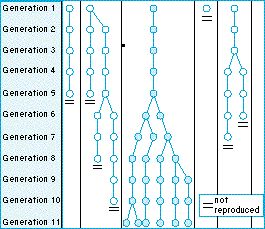Random events in population genetics - What are the consequences of genetic drift?

A small example
Just to explain the process, suppose that a tiny population is made up of five individuals, containing five A alleles and five a alleles. The genes are randomly sampled to produce the next generation. Maybe six A alleles are sampled and four a alleles. This is now the starting point to produce the next generation; the most likely ratio in the next generation is six A and four a : there is no 'compensating' process to push it back toward five and five. Maybe in the next generation six A and four a are drawn again. The fourth generation might be seven A and three a , the fifth six A and four a , the sixth seven A and three a , then eight A and two a , eight A and two a again, nine A and one a , and then 10 A . The same process could have gone off in the other direction, or started by favoring A and then reversed to fix a : random drift is directionless. However, as happens in the diagram, when one of the genes is fixed, the population is homozygous and will stay homozygous.
The effect of genetic drift on Hardy-Weinberg ratios
The Hardy-Weinberg equilibrium is a good approximation for all but small populations, and retains its importance in evolutionary biology; but it is also true that, once we allow for random drift, the Hardy-Weinberg ratios are not an equilibrium. The Hardy-Weinberg ratios are for neutral alleles at a locus and the Hardy-Weinberg result suggested that the genotype (and gene) ratios are stable over time. However, in a small population, gene frequencies drift about; one of the genes will eventually be fixed: and only then will the system be stable. The true equilibrium of the Hardy-Weinberg system in a small population is, so to speak, at homozygosity.
Figure: the evolutionary fate of six genes. Every generation, by chance some genes may fail to reproduce and others may leave more than one copy. Over time the population must drift to become made up of descendants of only one gene in an ancestral population. In this example, the population after eleven generations is made up of descendants of gene no. 4 (•) in generation 1.
| Next |



